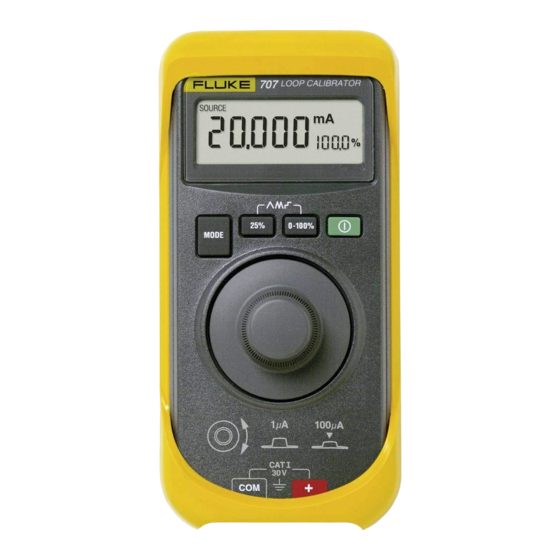
Fluke 707 Application Note
Loop calibration and maintenance
Hide thumbs
Also See for 707:
- Instruction sheet (17 pages) ,
- Specifications (1 page) ,
- Calibration information manual (10 pages)
Advertisement
Quick Links
Loop Calibration and
Introduction
Process instrumentation
requires periodic calibration
and maintenance to ensure that
it is operating correctly. This
application note contains
information to help guide tech-
nicians through some of the
more common loop calibration
tasks using Fluke tools.
Fluke loop calibrators are
ideal for a wide variety of cali-
bration applications. They
include:
•
Fluke 707 Loop Calibrator
•
Fluke 705 Loop Calibrator
•
Fluke 715 Volt/mA Calibrator
•
Fluke 787 ProcessMeter
A summary of the features of
Fluke's loop calibrators and a
glossary of terms are at the end
of this application note.
Field testing loop
powered isolators
The loop-powered isolator and
the two-wire isolating trans-
mitter are two of the more
prevalent devices in use in
4-20 mA control loops today
(see Figure 1). The testing and
troubleshooting procedures for
each are different and need to
be understood by the techni-
cians performing operational
checks on these units in the
field.
Maintenance
Figure 1
Loop-powered isolators
The main purpose of a loop
isolator is to eliminate ground
loops in control systems while
sending the control signal
current to another part of the
system. Loop-powered
isolators, unlike two-wire
transmitters, draw their operat-
ing power from the "input" side
of the isolator (see Figure 1),
which requires a pickup voltage
from 5.5 V to 13.5 V depending
on the manufacturer.
The output of the loop isola-
tor is an electrically isolated
mirror image of the input side
current. The compliance voltage
associated with the output is
greatly reduced from that of the
input side and ranges around
7.5 V. This produces a total loop
loading capability of 350 Ω.
This limited loop drive capabil-
ity is the primary limitation of
the loop isolator.
Application Note
Two-wire transmitters
Isolating two-wire transmitters
provide the same isolating
functionality as loop isolators
with the added advantage that
many provide signal condition-
ing for a variety of inputs such
as thermocouple, frequency, dc
current, RTD, strain gauge, and
other process inputs. The
power supplied to a two-wire
transmitter is connected to the
output side of the transmitter.
The two-wire transmitter mod-
ulates the current from the
power supply between 4-20 mA,
proportional to the input.
Typical power supplies for two-
wire transmitters range from
24 V to 48 V. Power supplies of
this size allow a significant loop
load capability on the output.
Advertisement

Summary of Contents for Fluke 707
- Page 1 Fluke tools. Fluke loop calibrators are ideal for a wide variety of cali- bration applications. They include: • Fluke 707 Loop Calibrator • Fluke 705 Loop Calibrator • Fluke 715 Volt/mA Calibrator • Fluke 787 ProcessMeter A summary of the features of Fluke’s loop calibrators and a...
- Page 2 To check linearity of the isola- of the loop-powered isolator. the controller output to a valve tor, push the associated % step 3. Place a Fluke 87, 187 or positioner. buttons up and down and con- equivalent multimeter (1 µA...
- Page 3 Step 2: Zero adjustment or feeling for movement of the checks. Set the 707 to an output of 4 valve stem. Minimize this move- mA and allow some time for Step 6: Stroking the valve ment using the span adjust-...
- Page 4 (1 mA = 1 V). The following example will utilize a 250 Ω to take advantage of the 0-100% and 25% buttons on the Fluke 707 (25% or 4 mA = 1 V). Constructing a precision current shunt Parts required: 1. Resistor: 1000 Ω...
- Page 5 25%, proper polarity. the 707. Adjust the zero con- 50%, 75% and 100% and 3. With the 707 set in the mA trol on the signal conditioner note the corresponding val- source mode, the display so the value of the output ues.
- Page 6 This example will show how large, adjustment may be or to a control room located a to use the 707 to verify a mA necessary. Normally, there distance away. These indicators input indicator. Make connec-...
- Page 7 Fluke Loop Calibrator Considerations and Selection Fluke loop calibration tools have a variety of different performance features and capabilities that differentiate the models. The charts below will help you determine which model best fits your needs: Loop Calibrator Volt/mA Calibrator...
-
Page 8: Glossary Of Terms
Fax (905) 890-6866 Other countries (425) 446-5500 or Fax (425) 446-5116 Web access: http://www.fluke.com ©2001 Fluke Corporation. All rights reserved. Trademarks are the property of their respective owners. Printed in U.S.A. 8/2001 1627722 A-ENG-N Rev A Printed on recycled paper.














Need help?
Do you have a question about the 707 and is the answer not in the manual?
Questions and answers